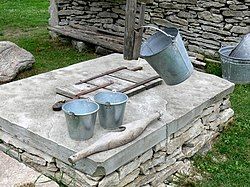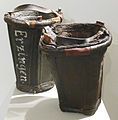Bucket


A bucket is typically a watertight, vertical cylinder or truncated cone or square, with an open top and a flat bottom, attached to a semicircular carrying handle called the bail.[1][2]
A bucket is usually an open-top container. In contrast, a pail can have a top or lid and is a shipping container. In non-technical usage, the two terms are often used interchangeably.
Types and uses
[edit]A number of bucket types exist, used for a variety of purposes. Though most of these are functional purposes, a number, including those constructed from precious metals, are used for ceremonial purposes. Common types of bucket and their adjoining purposes include:
- Water buckets used to carry water
- Household and garden buckets used for carrying liquids and granular products
- Elaborate ceremonial or ritual buckets constructed of bronze, ivory or other materials, found in several ancient or medieval cultures, sometimes known by the Latin for bucket, situla
- Large scoops or buckets attached to loaders and telehandlers for landscaping agricultural and purposes
- Crusher buckets attached to excavators used for crushing and recycling material in the construction industry
- Buckets shaped like castles often used as children's toys to shape and carry sand on a beach or in a sandpit
- Buckets in special shapes such as cast iron buckets or smelting buckets to hold liquid metal at high temperatures
Though not always bucket shaped, lunch boxes are sometimes known as lunch pails or a lunch bucket. Buckets can be repurposed as seats, tool caddies, hydroponic gardens, chamber pots, "street" drums, or livestock feeders, amongst other uses. Buckets are also repurposed for the use of long term food storage by survivalists.[3]
Shipping containers
[edit]When in reference to a shipping container, the term "pail" is used as a technical term, specifically referring to a bucket shaped package with a sealed top or lid, which is then used as a transport container for chemicals and industrial products.[4]
Gallery
[edit]-
Roman bronze situla from Germany, 2nd–3rd century
-
A wooden bucket
-
German 19th century leather firebuckets; the most common material used for buckets, alongside wood, before the invention of many modern materials was leather
-
A man carrying two buckets
-
A young lady carrying a bucket, drawing by German artist Heinrich Zille
-
A crusher bucket
-
A plastic yellow bucket
-
A metal bucket
English language phrases and idioms
[edit]The bucket has been used in many phrases and idioms in the English language,[5] some of which are regional or specific to the use of English in different English-speaking countries.
- Kick the bucket: an informal term referring to someone's death
- Drop the bucket on: to implicate a person in something (from Australian slang)
- A drop in the bucket: a small, inadequate amount in relation to how much is requested or asked, taken from the biblical Book of Isaiah, chapter 40, verse 15[citation needed]
- Bucket list: a list of activities an individual wishes to undertake before death
Unit of measurement
[edit]As an obsolete unit of measurement, at least one source documents a 'bucket' as being equivalent to 4 imperial gallons (18 L; 4.8 US gal).[6]
See also
[edit]- Bobrinski Bucket
- Giberville bucket
- Bucket brigade
- Coal scuttle
- Mop
- Pail (container)
- There's a Hole in My Bucket
- Veronica Bucket
References
[edit]- ^ "Bucket". Merriam-Webster. Archived from the original on 9 September 2013. Retrieved 23 August 2013.
- ^ Flexner, Stuart; Hauck, epmpre, eds. (1993) [1987]. Random House Unabridged Dictionary p (hardcover) (second ed.). New York: Random House. p. 271. ISBN 0-679-42917-4.
- ^ Durado, John (22 February 2017). "Gamma Lids for Long Term Storage". Pyramid Reviews - Prepping for Life. Archived from the original on 3 March 2017. Retrieved 3 March 2017.
- ^ Soroka, W. Illustrated Glossary of Packaging Terminology (Second ed.). Institute of Packaging Professionals. Archived from the original on 2011-01-29.
- ^ Klein, Herbert Arthur (3 December 2012). The Science of Measurement: A Historical Survey. ISBN 9780486144979. Retrieved May 23, 2018.











